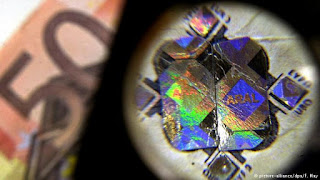Friday, February fourteenth, the UN says at least 22 people have been killed in a village in the Northwest region of Cameroon. Over half of those killed were children. No one has claimed responsibility for Friday’s incident but the opposition parties blame the killing on the government.
Counterfeit money crimes, fake euro notes in a rise in Europe
- Get link
- Other Apps
Counterfeit money crimes rose by a whopping 42 percent in
Germany last year, according to a new federal report. Authorities have
attributed the spike in crime to better quality fakes and online sellers.
Last year, 86,500 cases were registered by authorities - easily doubling data from 2011 and marking a 42 percent leap up from 2014's numbers.
Fake euro notes and counterfeit
money crimes both rose drastically in 2015, according to a report
released on Monday by Germany's
Federal Criminal Police Agency (BKA).
Last year, 86,500 cases were registered by authorities - easily doubling data from 2011 and marking a 42 percent leap up from 2014's numbers.
A total of 112,000 faked bills with a
nominal value of 5.5 million euro ($6.37 million) were removed from circulation
in Germany in 2015, marking a 48 percent increase compared to the year before.
Although the 20-euro-note is the most popular
bill to fake in the European Union, in Germany the "false
fifty" comprised exactly half of the confiscated counterfeit euros, with
the 20-euro-note coming in at 37 percent.
The BKA reported some good news as well -
there were fewer faked euro-denomination coins discovered in 2015, dipping down
by almost 25 percent.
Better quality in
false notes
According to the report, the stark rise in
counterfeit euros is due to underground
internet-markets in the so-called "Dark Net." Alongside
the faked notes, online buyers can purchase materials for making their own
copies as well as instructions and hologram, three-dimensional images.
The counterfeiters also were able to mimic
more security features, such as micro-printing and tactile features, which
improved the quality of the fakes and made them harder for people to detect.
The BKA noted that most of the
"high-quality fakes" were produced in eastern and southern Europe,
"mainly from Italy."
Since most of the notes in 2015 were
uncovered at banks and cash-in-transit firms, the BKA concluded that the
majority of individual users of cash do not recognize the fakes - especially
since most everyday payments do not involve a detailed examination of the cash.
Despite improved counterfeit quality,
authorities maintained in the report that "the majority of counterfeit
banknotes can be detected without the use of technical aids."
Popular posts from this blog
Entrance design of "Church Of Luminants" in USA
UN says at least 22 people including children killed in Cameroon's English-speaking region
Cameroon automobile industry company S.A. (CAIS) received 15 hectares of land for its car project
The planned construction and vehicle assembly in Cameroon is gradually being realised. The Cameroon automobile industry company S.A. (CAIS), Indo-chinese group bearer of this project formally got this Thursday, March 10, 15 hectares of land, granted by the Mission of development and planning of industrial zones (MAGZI). The ceremony was held there in Yaounde by the Minister of Mines, Industry and Technological Development Ernest Ngoua Boubou, in the presence of the Director General of MAGZI, Christol Georges Manon, and representatives of the CAIS group. Following the lifting of the main constraint for the project, the Indo-chinese group announced the laying of the foundation stone which will take place by June 2016. CAIS will implement its plants in two cities: Douala and Kribi. The project aims, according to its developers, to create more than 4,000 direct jobs.




Comments
Post a Comment